Symphony No.7
音楽 / L.V.ベートーヴェン「交響曲第7番」
振付 / ウヴェ・ショルツ
振付指導 / ジョヴァンニ・ディ・パルマ
バレエミストレス(ゲスト) / 木村規予香
バレエミストレス / 山口智子 加藤浩子
衣裳協賛 / チャコット株式会社
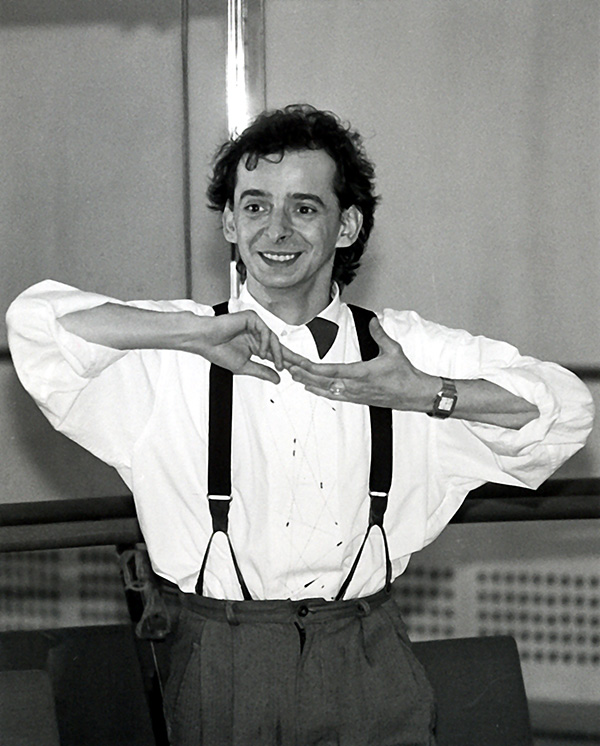
振付
ウヴェ・ショルツ
Uwe Scholz
1958年12月31日、ドイツ、ダルムシュタットに生まれる。4歳にてバレエを始め、1973年シュツットガルト・バレエ学校に入学。1979年に卒業、同年シュツットガルト・バレエ団に入団。 1982年シュツットガルト・バレエ団の常任振付家に就任。就任以来、シュツットガルトをはじめ、ミラノスカラ座バレエ団、モンテカルロバレエ団、ウィーン州立バレエ団などの世界的なバレエ団の振付をする。 1985年スイス、チューリッヒバレエ団の振付家兼芸術監督への就任を経て、1991年ドイツのライプツィヒ・バレエ団の振付家兼芸術監督に就任。 1996年、国民栄誉賞を受賞。同バレエ団をドイツ、ヨーロッパのみならず世界有数のバレエ団に育てる。20年間に90曲を超える作品を振付けるが、2004年11月21日に45歳の若さで急逝。
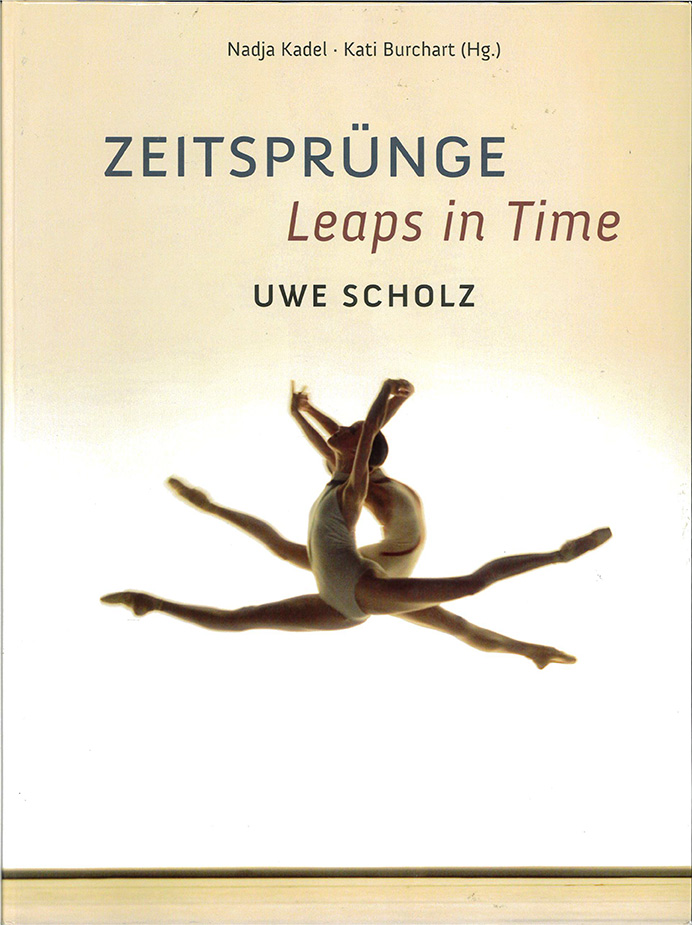
ガブリエレ・ブランドステッターによる紹介、ヴォルクマル・ドレーガーによる作品分析、アーティストへのインタビューを含む、ウヴェ・ショルツの作品に関する初の出版本。
著:Nadja Kadel・Kati Burchart
The really special thing about Uwe’s work is that he for example, after a long series of pirouettes and technically difficult jumps – choreographed something very simple, very touching and intimate, with hardly any steps The contrast was always very impressive!
ウヴェ作品で本当に特別なのは、例えば、長いピルエットや技術的に難しいジャンプの後に、ほとんどステップを踏まず、とてもシンプルで、とても感動的な親しみやすい振付をすることです。そのコントラストは、いつもとても印象的でした!
He had his own, very distinct taste and it was almost as if he was saying: “I don’t care what the audience is thinking. I’m doing this for myself and for my dancers”. It was quite touching to see that he could do both: he could go from extremely difficult technique to just a gesture, an arm movement or a walk, and this had an incredible impact.
彼は彼自身の、非常に独特なテイストを持っていて、まるでこう言っているかのようでした: 「観客がどう思うかなんて気にしない。自分のため、ダンサーのためにやっているんだ」非常に難しい技術から、ジェスチャーや腕の動き、ふるまい方まで、両方ができるのは感動的でしたし、それが驚くべきインパクトになっていました。
Moments when, for example, the corps de ballet was not entirely synchronic, everyone in the audience seemed to be dancing with us or wanting to do so.
例えば、コール・ド・バレエが完全にシンクロしていない瞬間があったとしても、観客の誰もが私たちと一緒に踊っている、あるいは踊りたがっているように見えました。
Beatriz de Almeida on “Beethoven’s The Seventh Symphony”
ベアトリス・デ・アルメイダが語る“ベートーヴェン 交響曲第7番”
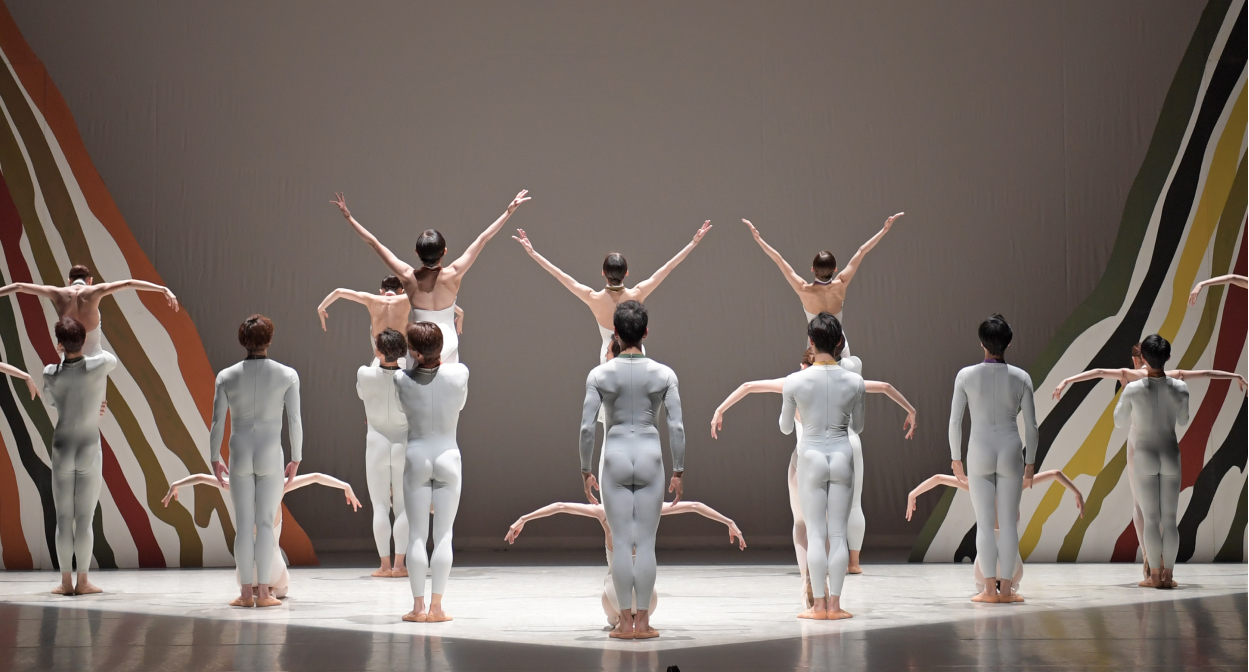
『The Seventh Symphony』Choreography
With their backs to the audience twelve couples stand on an acute triangle of white light and gaze at the scenery: a blue background shines between the “wings” of a garishly striped “phoenix”.
As the music of the first movement (Poco sostenuto – Vivace) begins, three women are lifted one after the other and gently set down with arms like birds’ wings. The group divides into three and the men carry their partners in the flying position around the space.
The leading couple remains, supported by two further couples as if they were the artistic shadow of the solo action. Behind them the team of men pass by, holding hands; behind the “wings” the women leap past one after the other as if in a living frieze.
The men arrange themselves into a diagonal and form a row out of this. This formation repeats itself a number of times. The soloist pulls his partner in the splits across the floor. The two couples replicate the introductory flying position which is then taken up by the leading couple.
As the soloist bids farewell, his partner dances a variation, as fluent as it is relaxed. Five women split from their partners and the leading couple appears through the alleyway between the “wings”, accompanied by their two couples. All the ensemble couples do the splits like the soloists and the women leap at their partners one after the other.
Those overstretched lines typical of Scholz appear once again: overstretched splits, attitude positions executed over the head. When three women position themselves right up close to the soloist, this is possibly a quotation from Balanchine’s Apollon musagète. The men drive in a grand jeté through four vertical rows towards each of the three women.
The women mass together out of a semi-circle, then dissolve as if hesitating in the middle of a game. The two women push their heads playfully into the stomachs of their partners as if in battle, and as it paces the ensemble seems to have begun trying to find their way to something, gazing in alliance at the audience. The movement ends with a lifting pose.
Blue light is beamed around six standing couples.
12組のカップルが客席に背を向け、白い光の三角形の上に立ち、舞台装置を見つめる。
派手な縞模様の「不死鳥」の“翼”の後ろに青い背景が輝く。第1楽章(Poco sostenuto – Vivace)の音楽が始まると、3人の女性が次々と持ち上げられ、翼のような腕で優しく降ろされる。
グループは3つに分かれ、男性たちは飛行姿勢のパートナーを担いで空間を回ります。先頭のカップルはそのまま、さらに2組のカップルに支えられて、まるでソロ・アクションの芸術的な影のようです。
その後ろでは男性たちが手をつないで通り過ぎ、“翼”の後ろでは女性たちが生きたフリーズ(帯状の装飾彫刻)のように次々と跳躍していく。男性たちは対角線上に並び、そこから一列を作る。
このフォーメーションは何度も繰り返される。ソリストがパートナーを引き連れ、フロアを横切ります。2組のカップルは序奏のフライングポジションを再現し、その後、先頭のカップルがそれを行う。
ソリストが別れを告げると、パートナーは流暢に、そしてゆるやかにバリエーションを踊ります。5人の女性がパートナーから離れ、先頭のカップルが2組のカップルに連れられて“翼”の間を抜けて登場する。
アンサンブルのカップルは全員、ソリストのように別れて、女性たちは次々とパートナーに飛びかかる。ショルツらしい伸びやかなラインが再び登場する。
伸びやかなスプリッツ、頭上で行うアティテュード。3人の女性がソリストのすぐ近くに位置するのは、バランシンの『アポロ』からの引用かもしれない。
男性陣は、縦4列をグラン・ジュッテで走り抜け、3人の女性それぞれに向かっていく。女性たちは半円を描くように集まり、戯れの途中で逡巡するように散っていく。
2人の女性は、じゃれあいながらバトルするように、相手の腹に頭を押し込み、歩を進める。そのうちにアンサンブルは何かに辿り着こうとし始めたようで、集まって観客をじっと見つめている。
最後はリフティングのポーズで締めくくられる。6組の立ち姿のカップルを囲むように、青い光が照射される。
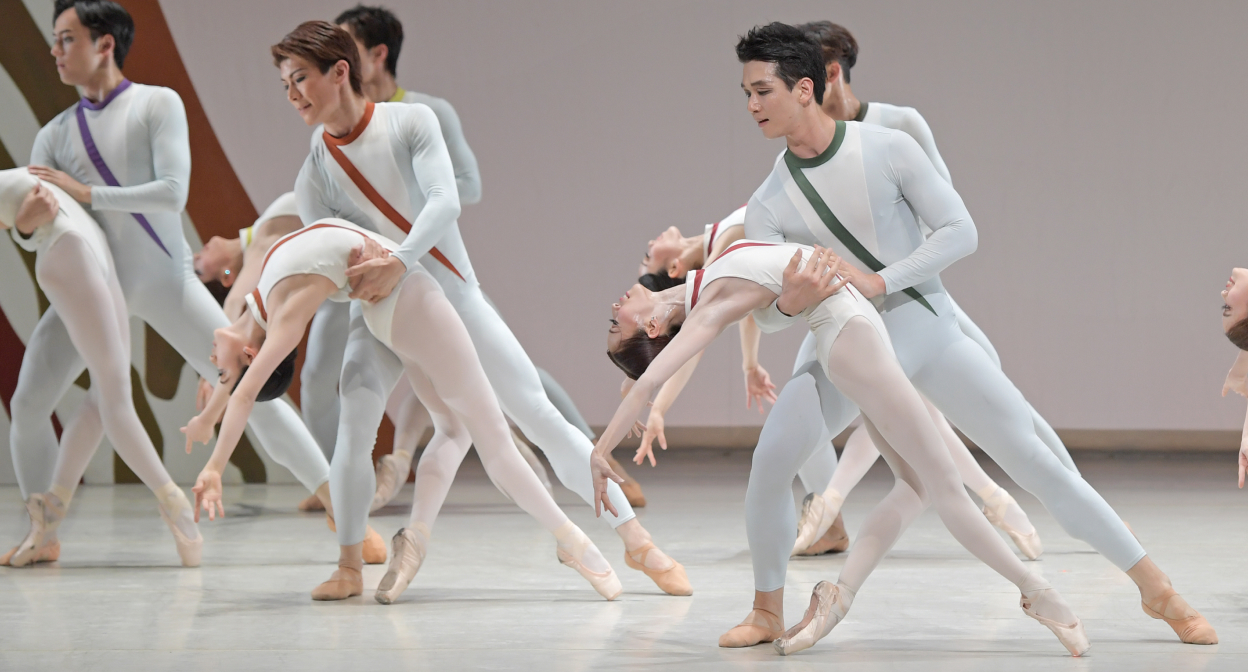
In the second movement (Allegretto). The leading couple the same man but a different partner slowly begins the dance, accompanied again by two couples. The leading couple walks to the right, followed by the accompanying couples as the light changes from light to dark pink. As the women run up to them, the men lift them up, resisting their onrush and turning them back in the direction they came from. The leading couple introduces the repetition of the whole sequence since the beginning of the movement. The couples turn and go back into the blueness of the beginning, listening to the music, and after that the light forms into a circle that then splits into two circles. Separately, yet with a gentle understanding, the partners leave the stage.
第2楽章(Allegretto)。先頭のカップル(同じ男性だがパートナーは異なる)が、再び2組のカップルと同時に、ゆっくりとダンスを踊り始める。 光の色が薄いピンクから濃いピンクに変わると、先頭のカップルが右へ歩き、それに続いてカップルが歩く。 女性たちが駆け寄ると、男性たちは彼女たちをリフトし、その突進に抵抗して元いた方向に引き返させる。先頭のカップルは、第2楽章が始まって以来、すべての動作が繰り返されている様を披露する。 カップルは音楽を聴きながら振り返り、始まりの青色の中に戻っていくが、その後、光は円形になり、やがて分裂する。 光が円形になり、2つの円に分かれる。別々に、しかし穏やかな合意の元、パートナーはステージを去る。
A male dancer opens the third movement (Scherzo. Presto) with a brisk solo, leading in three couples. A man bears his partner in through the “wings”, holding her up at a height in the lying position and accompanied again by two couples. As trios join them the dancers, tightly holding hands, form a semi-circle in the deep blueness around a magic, white spot of light, extending the semi-circle. After his exit another male dancer replicates exactly his fellow dancer’s variation from the beginning of the movement, and the action that followed from that point is repeated again. All the dancers form the second magic spot in two concentric semi-circles. As they perform the repetition, both male dancers synchronise their variation. The dance ends for everyone en face on one knee and with arms stretched out.
第3楽章(スケルツォ、プレスト)は、男性ダンサーの爽やかなソロで始まり、3組のカップルがリードします。 男性が“翼”からパートナーを担いで登場、寝たままの姿勢で高さを保ち、再び2組のカップルと共に踊る。トリオが加わると、ダンサーはしっかりと手をつなぎ、深い青色の中で半円を描き、神秘的な白い光が半円を広げていく。 男性ダンサーが退場した後、別の男性ダンサーが冒頭のバリエーションをそっくり再現し、そこから続く動作が再び繰り返される。全員が2つの半円を描くように、2つ目の神秘的な光を形成する。 この繰り返しで、男性ダンサーは2人のバリエーションをシンクロさせる。全員、片膝を立てて両手を広げ、第3楽章は幕を閉じる。
In the fourth movement (Allegro con brio) the tempo picks up again. The leading couple of the first movement sets the tone, furiously lifting and throwing and then lifting upside down. They appear to be flirting with one another, and also the two men of the third movement perform solos. There are several vertical rows, and at one point the women form a rotating “girl line-up”. The female soloist runs out of this line-up into her partner’s arms. The couple repeatedly finds itself caught up in the throng of people, and it appears to be playing a cheerful game of hide and seek. She performs fast and frenzied pirouettes in his hands, and both seem to share in each other’s joy. All the men, in high spirits, throw the female soloist in the air; the women join them and take up the attitude position, forming an elegant tableau as the light goes out abruptly.
第4楽章(Allegro con brio)では、再びテンポが速くなる。第1楽章の主役のカップルが、激しく持ち上げては投げ、持ち上げては逆さまにして、雰囲気を作り上げており、互いにじゃれあっているようにも見える。第3楽章の2人の男性もソロを踊っている。 縦列がいくつもあり、あるところで女性たちがくるくる回る「ガールラインアップ」を形成する。女性ソリストは、この列からパートナーの腕の中に飛び込んでいく。 人の波に巻き込まれたカップルは、まるで陽気なかくれんぼをしているようだ。 彼女は、彼の腕の中で高速のピルエットを披露し、お互いの喜びを分かち合っている。 意気揚々と男性たちが女性ソリストを宙に投げ、女たちもそれに加わって姿勢よく構え、優雅なタブローを形成したところで、突然の消灯となる。
『ベートーヴェン 交響曲第7番』の音楽
「交響曲第7番」イ長調Op.92 L.V. ベートーヴェン
<解説>
ベートーヴェンが1811年から1812年にかけて作曲した交響曲。
リストがこの曲を「リズムの神化」といい、ワーグナーは各楽章におけるリズム動機の活用を指して、この曲を舞踏の聖化 (Apotheose des Tanzes) と絶賛している。
この曲の大きな特徴は、全体をつらぬく、その生命力にあふれたリズムである。
これほどリズムを重用し、それを絶妙に展開した交響曲は、当時としては型破りのものであったと言われている。
第1楽章
ポコ・ソステヌート(Poco Sostenuto) – ヴィヴァーチェ(Vivace)
イ長調 ソナタ形式 4分の4拍子 - 8分の6拍子
すべての楽器による強奏(トゥッティ)を、オーボエのソロが紡ぐことで幕を開ける。
上昇系の音階が特徴的に続く序奏の後は、軽快なリズムが楽章全体を通して続き、弦楽器と管楽器が対比と呼応を繰り返しながら一体化していく。
第2楽章
アレグレット(Allegretto)
イ短調 複合三部形式 4分の2拍子
初演時に聴衆より最も支持をうけた楽章であり、ワーグナーより「不滅のアレグレット」と評された。
同じ旋律が繰り返される静的な旋律でありながら、和声的には通して豊かに彩られている。
第3楽章
プレスト(Presto)
ヘ長調 三部形式 4分の3拍子
急速で激しいリズムが続く主題部分に対し、中間部のトリオの旋律は、オーストリア北東部の巡礼歌によるものと言われている。
第4楽章
アレグロ・コン・ブリオ(Allegro con brio)
イ長調 ソナタ形式 4分の2拍子
エネルギッシュなリズムが狂喜乱舞する熱狂的なフィナーレ。
第1主題は中心の展開部でも扱われ、125小節におよぶ長大なコーダは、凄まじい緊張を讃えながらクライマックスを締めくくる。
バレエマスター(ゲスト)ジョヴァンニ・ディ・パルマより
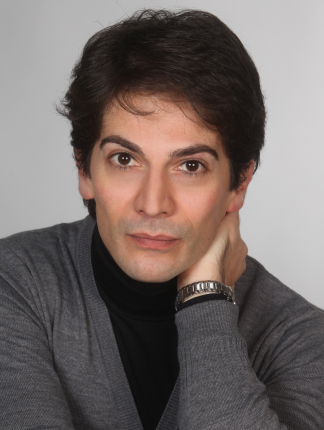
元ライプツィヒ・バレエ団プリンシパル
ジョバンニ・ディ・パルマ
Giovanni di Palma
イタリア生まれ。ローマ国立アカデミー卒業後、ローマ歌劇場、ニースオペラ劇場で踊り、1997年ドレスデン・バレエ団入団。 ライプツィヒ・バレエ団移籍後、2000年、同団監督ウヴェ・ショルツによりプリンシパルに抜擢、2003年、彼のために振り付けられたストラヴィンスキー『春の祭典』ピアノ版ソロを踊る。 2008年、カンヌで行われたパレ・デ・フェスティバルにて「レ・エトワール・デュ・バレエ2000」を受賞。その他、ドイツ、イタリアにて受賞。 その後香港、マイアミ、マルセイユ、ローマ等、世界のガラ公演にゲストダンサーとして招聘される。 長年に渡り、国際的なバレエ・マスターとして、ウヴェ・ショルツ、マルコ・ゲッケより指導を一任され、世界中で多くの作品の再演に携わっている。
“Uwe Scholz and TCB: a pure joy and stunning dancers. A great pleasure working with those beautiful souls.”
